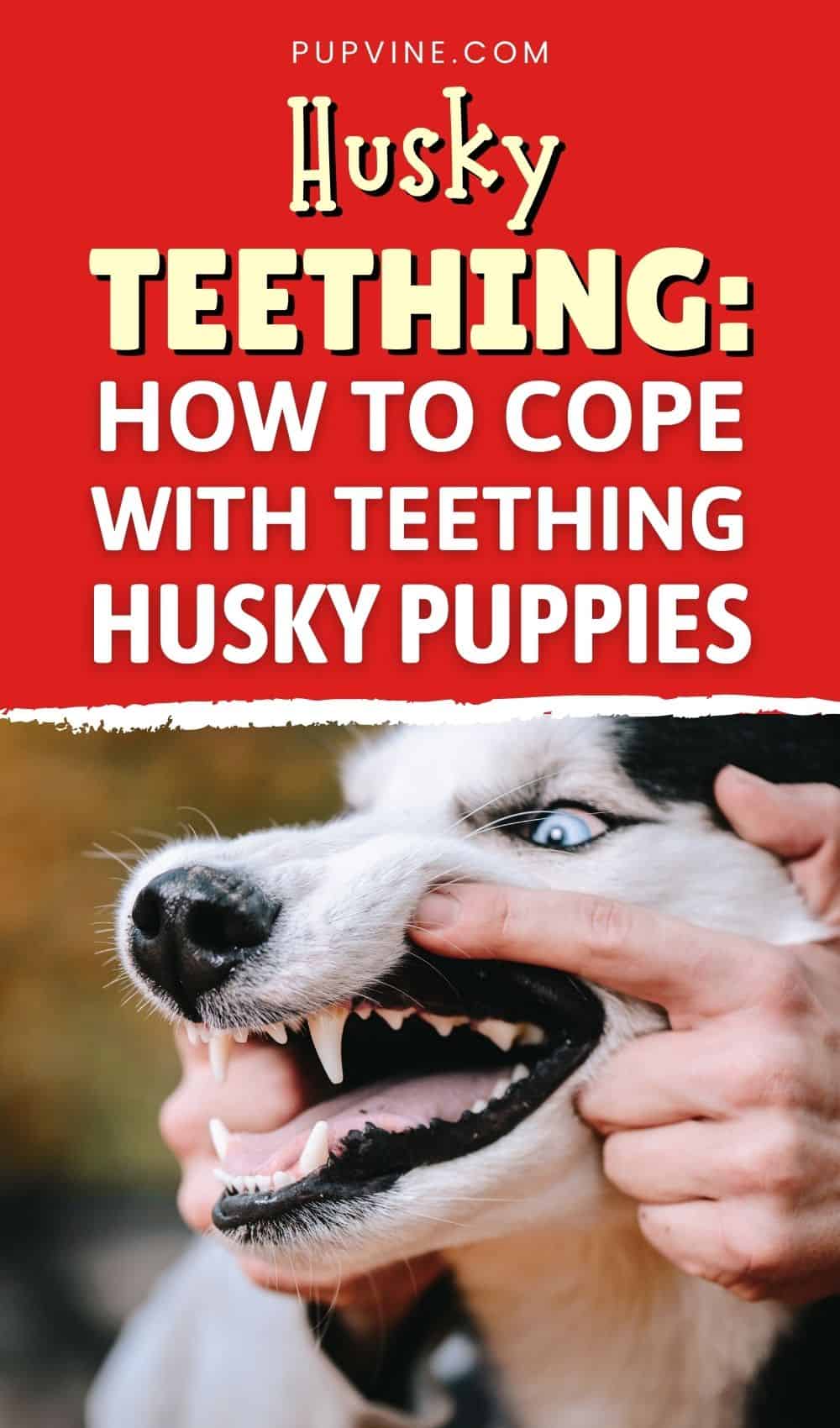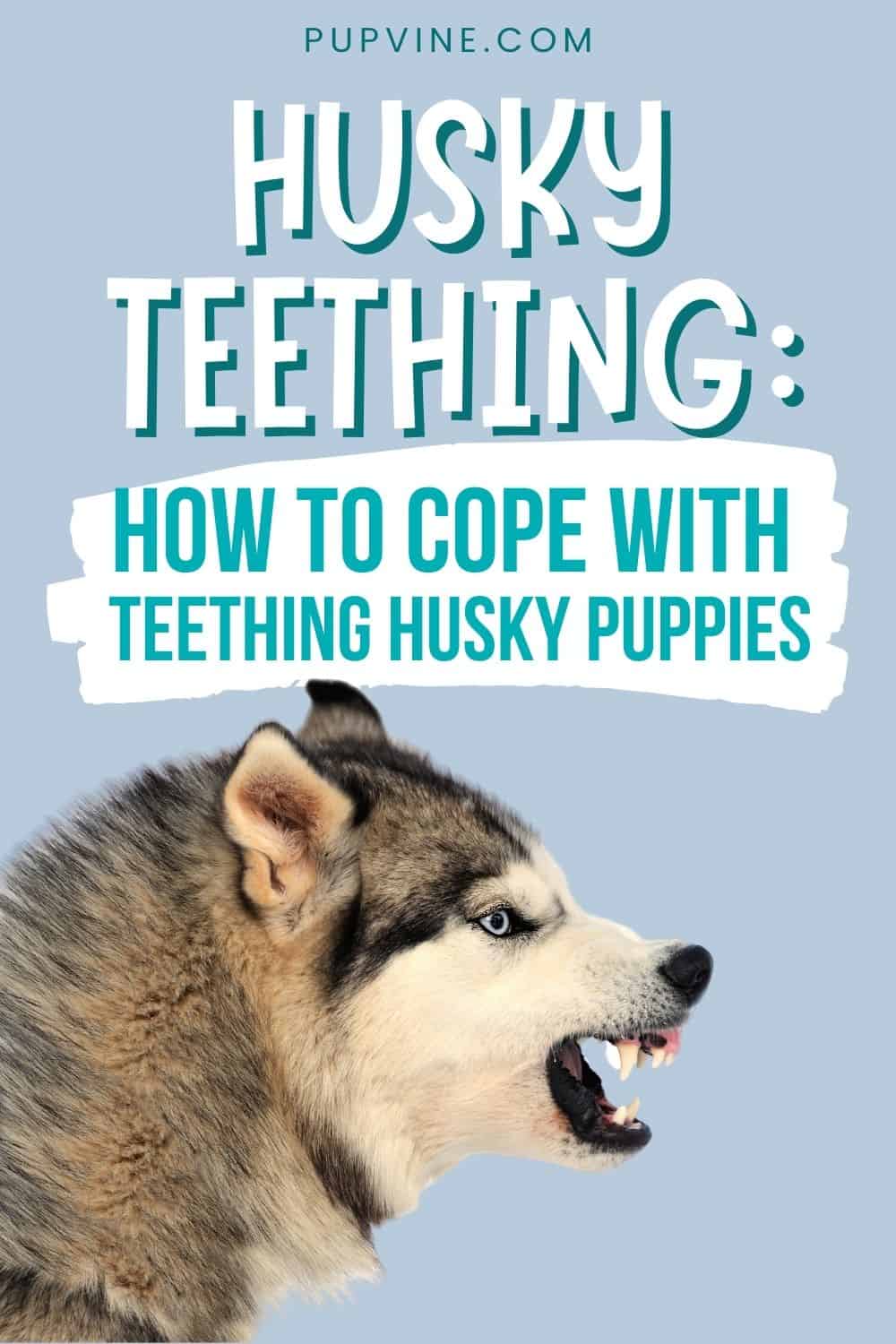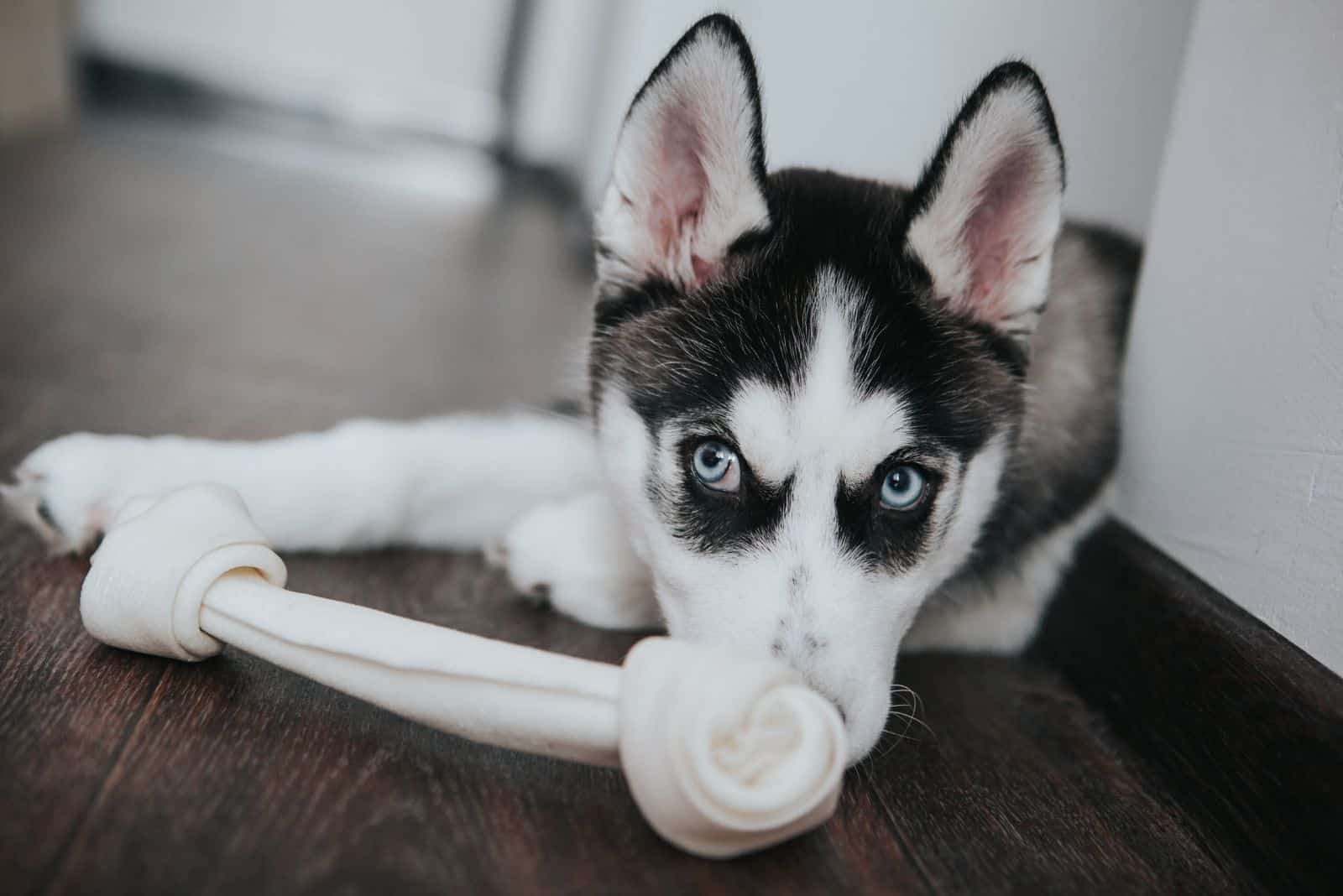The teething process can be a tough time for the little ones going through it. Many of us have looked on helplessly as we witness our own children experiencing the pain and discomfort of teething.
Just like human babies, puppies are born without any teeth. They then have to go through the same process of growing baby teeth, which will be replaced by adult teeth very soon afterward.
This happens much more quickly in dogs, mainly because they have a shorter lifespan.
That doesn’t mean to say that it is any easier or any less painful for them! Although some pups seem to deal with this better than others, the whole process can be very trying – for the puppy, as well as the dog owner.
This guide is designed to steer you through the Siberian Husky teething process, letting you know what to expect and what signs to look out for. We’ll also throw in some helpful tips at the end that should soothe your furry friend’s painful gums.
As we make our way through the guide, you might see similar questions being asked in different ways or the same things being repeated. This isn’t a mistake! It’s just our way of making sure that you have all the information you need to get through this tough time.
Siberian Husky Teething
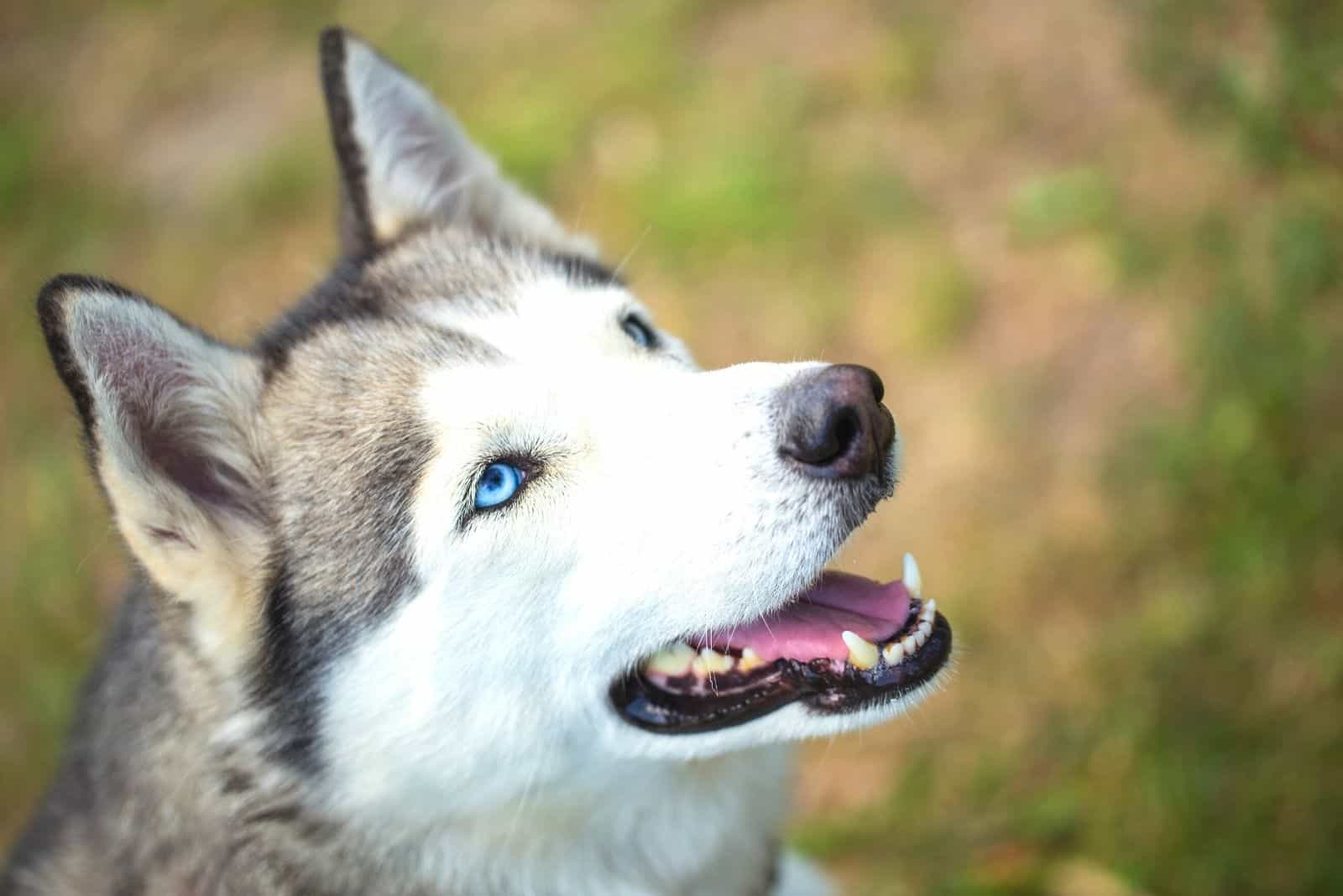
Every puppy is born without teeth, which is great news for the mother, as she will be nursing those pups for a few weeks! However, those tiny baby teeth will start to grow within 6–8 weeks, around the time that they should be weaned onto solid foods.
Those teeth are sharp for a reason: the mother will discourage the pup from feeding (which is no surprise!), and so the pup is forced to seek nourishment elsewhere. In the wild, they would be using these new teeth to tear into solid food, such as raw meat, instead of relying on their mother’s milk.
They won’t have these little, pin-like teeth for long, though. Between 3–7 months of age, these will fall out to be replaced by the adult teeth.
Signs Of Teething
The first noticeable sign of teething is when your puppy starts chewing. He’ll chew on anything, usually starting with your fingers, which will hurt at times.
Nothing will be safe from those tiny jaws, including shoes, furniture, TV remotes, cell phones – you name it, and your pup will be sure to chew on it.
This is a good time to move anything out of reach if you want to keep it from being chewed! In fact, it’s a good idea to keep your pup contained in a small area if you haven’t done so already.
Chewing and biting are all a natural part of their development, and you shouldn’t stop them from doing it.
However, you do want to discourage them from chewing the wrong things, and they should stop this behavior by a certain age. We’ll come back to this point later, as it can become a problem.
You may also notice that they drool a lot – and we mean, a lot! This is because their gums are inflamed and irritated, which increases the amount of saliva they produce.
They will also whine more than usual. Puppies like to make noise; it’s another natural part of their development. They test their vocal range by yapping, growling, and whining. It’s all very cute and brings a smile to our faces, but constant whining can be tiresome.
Any Other Problems?
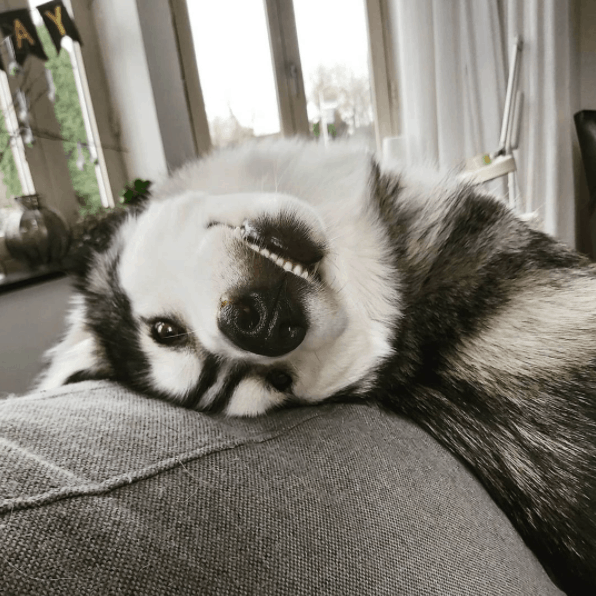
Here’s where you need to take care: increased whining could be a sign that something else is wrong. If your pup is suffering from something other than teething pains, you need to know for sure so that you can take action.
Watch for any other signs that will help you to understand the problem. If your pup experiences vomiting or diarrhea (especially if it is severe and the diarrhea has blood in it), then you should seek veterinary advice.
Responsible breeders will vaccinate against diseases such as parvovirus and distemper and start the deworming process (all pups are born with worms).
However, the shots are taken in three doses over the first year or so of the pup’s life, so you will need to make sure these are administered on time. You will also need to continue the deworming treatment.
If your Husky pup hasn’t been vaccinated, their shots aren’t up to date, or perhaps they haven’t been dewormed properly, then they may be vulnerable to disease and infection.
This could be the reason for excessive whining, and you’ll need to get them checked over at the vet immediately as these conditions can be serious – parvovirus has a mortality rate of 91%.
Another sign of Husky teething is that they may seem to lose their appetite. It’s not so much that they aren’t hungry, but the action of eating hurts their gums and teeth, especially if they are fed kibble.
Red, Swollen, Bleeding Gums
Check inside your new puppy’s mouth to see those gums. They’ll probably look very red and swollen. You will notice spots of blood on the things they chew.
This is entirely normal, but once again, you need to be alert: excessive bleeding is not good. If you notice a lot of blood, then it’s best to get it checked out just to rule out any potential health problems.
See Also: Dog Gum Color Chart: 5 Dog Gum Colors To Look Out For
Adult Teeth
Eventually, these permanent teeth will grow, and you can sit back and relax! Well, the ordeal of teething will be over, but then you have the responsibility of looking after a furry member of the family who will be with you for the next fifteen years or so.
Husky Teething Age
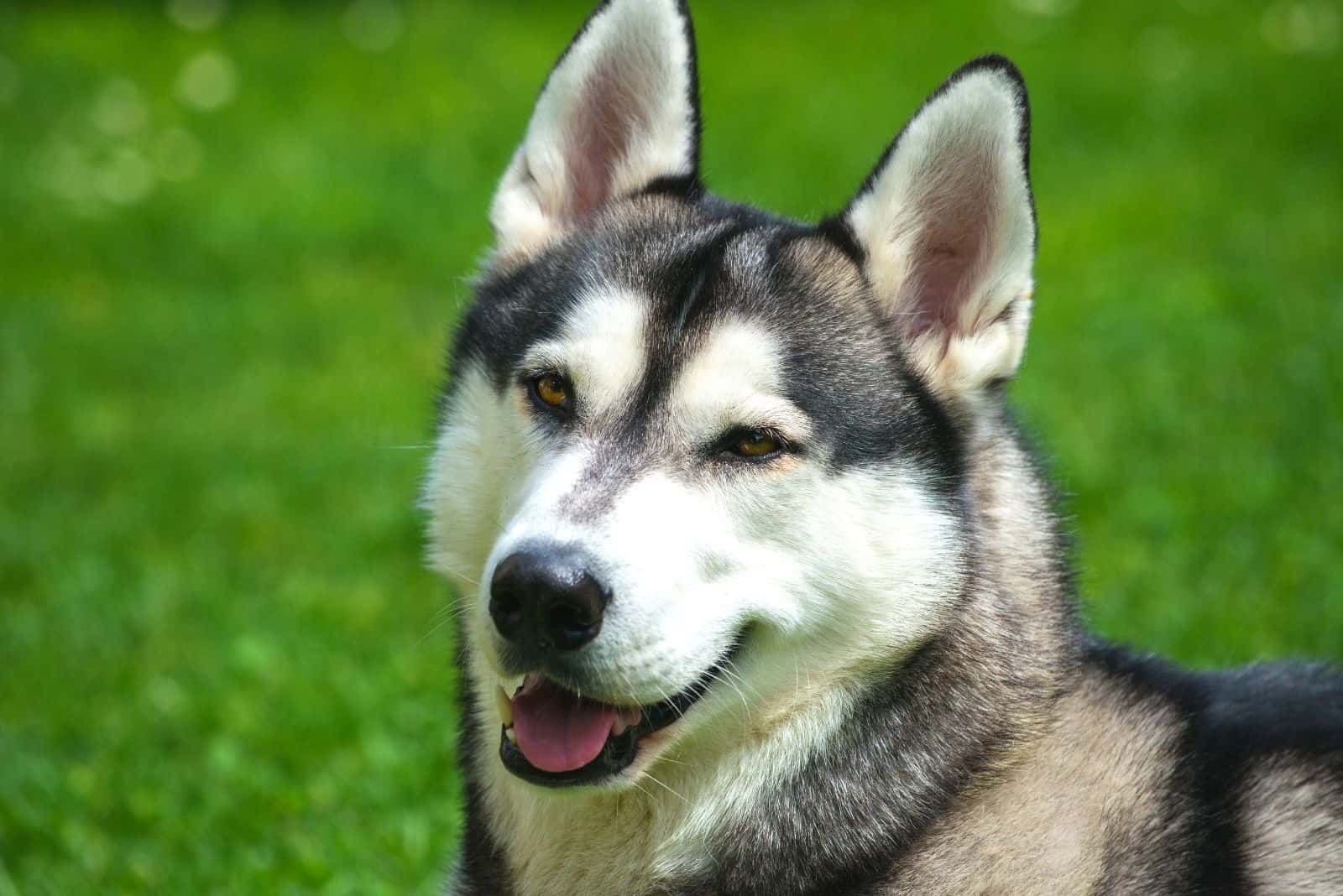
You could say that there are two Husky teething stages. The first is when their baby teeth grow, and the second is when these fall out and are replaced by their adult teeth.
The timescale is general, as some pups will develop earlier and others much later. It’s fair to say that the whole first 8 months of their lives are taken up with the teething process, though it can come and go in peaks and troughs.
Husky milk teeth start to grow at around 6–8 weeks of age. These are very small and pretty sharp, ready for when the puppy starts to eat solid food.
These tiny teeth are also known as deciduous teeth for fairly obvious reasons. The incisors are the first to appear, followed by the canine teeth, and then the premolars. In most cases, pups will have 28 of these all told.
Then, at between 3 and 7 months of age, these will fall out in the same order as they appeared. You may find some of these little teeth lying around, but don’t worry if not. Puppies will often swallow these while eating and be none the worse for it.
One or two teeth might hang on stubbornly, but don’t be tempted to pull them out! You might damage the root or gum. If you are concerned, take your fur baby to the vet, and they’ll take care of it for you.
The 42 adult teeth will then start to grow through, and it can take up to four months for them to do so. So, between the ages of 6 weeks and 7 months, your poor pup will be going through periods where their teeth and gums are sore.
How Long Does Husky Teething Last?
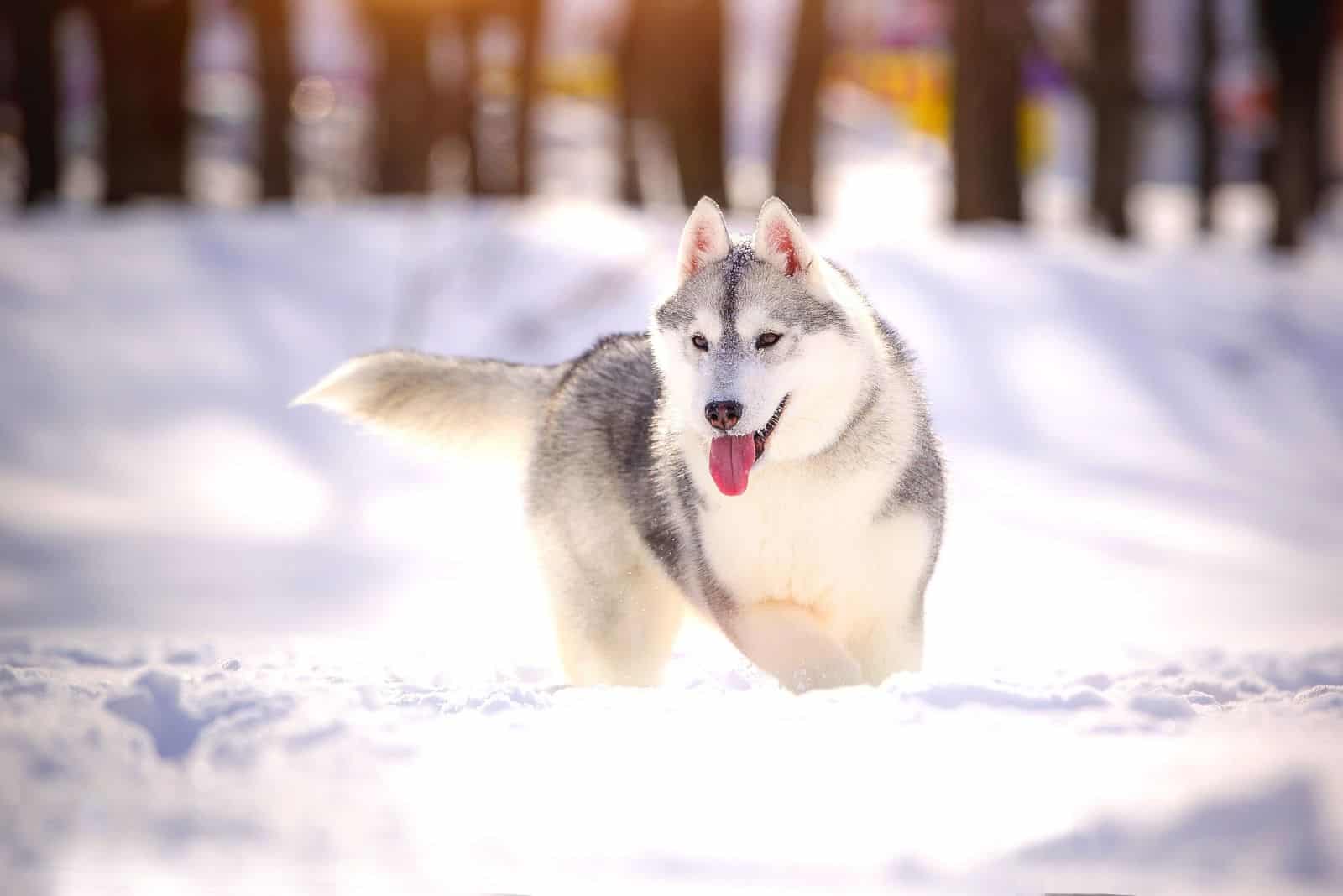
As mentioned above, Husky teething can last for up to six or seven months. It tends to go in phases, with the incisors growing first, then the canine teeth, and finally the premolars.
It won’t always be bad, as there will be times when the teeth aren’t actively growing. The worst part will be around the 6–8 week mark when the deciduous teeth (or milk teeth/baby teeth) erupt through the gums.
When these fall out, the gums will be sensitive again. Likewise, when the permanent adult teeth start to grow (which can take some time), your Husky puppy is going to seek relief by chewing and biting everything.
This stage can last from around 3 months right up to 7, or maybe 8 months of age. In very rare cases, this can take longer. If it does, then you might want to seek help and advice from your vet, just to make sure there’s nothing wrong.
Why Do Baby Huskies Bite So Much?
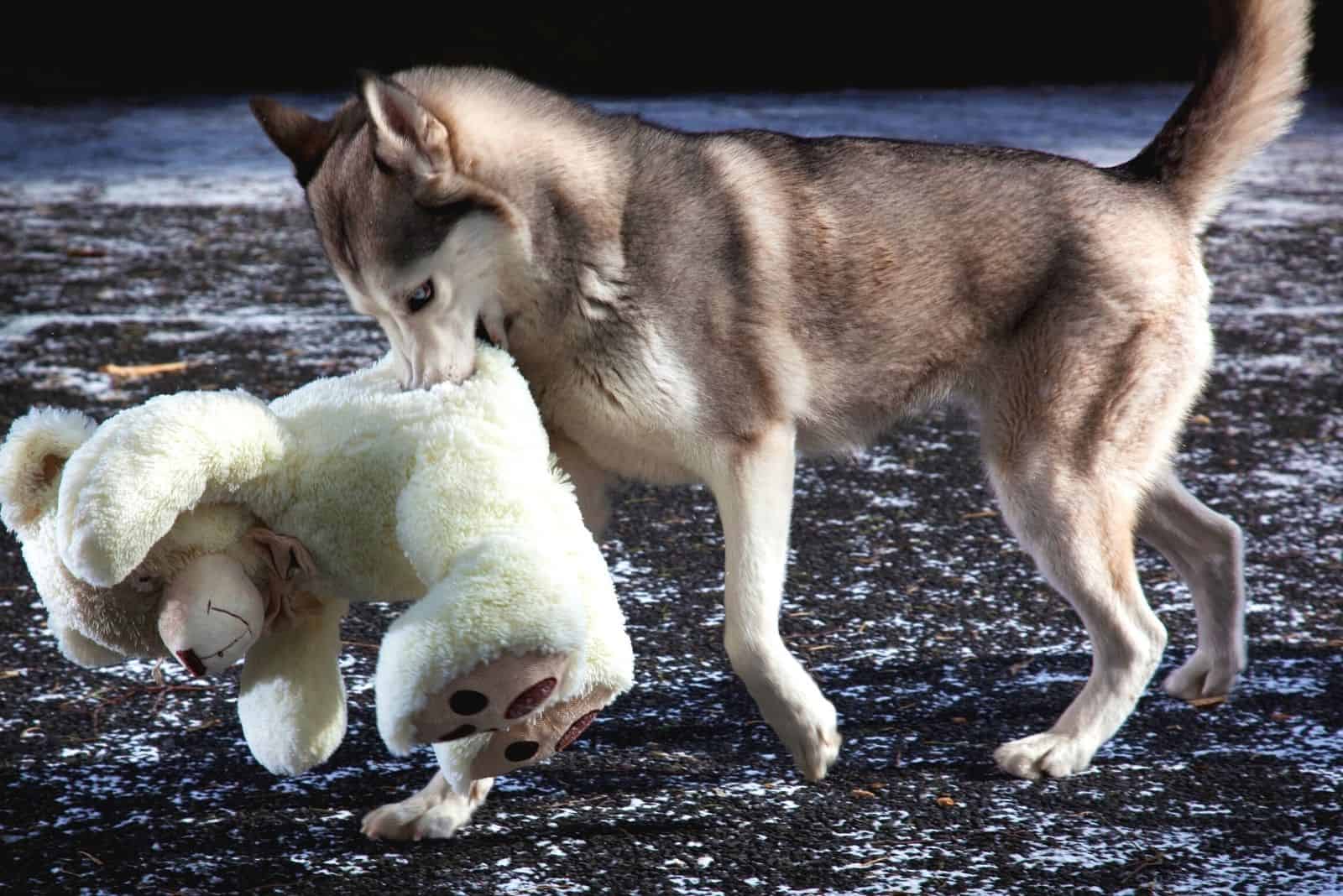
It’s just what they do! It might seem an unsatisfactory answer, but biting comes naturally to all puppies and Siberian Huskies in particular. And it isn’t only limited to the Husky teething process!
Huskies are well-known to be aggressive chewers. They have powerful jaws that will shred all sorts of materials. This is annoying for you, but it can be a hazard to the puppy.
Imagine that they’ve chewed through the fabric of your sofa and reached the foam inside. There’s a chance that they can choke on small pieces or that they enter the dog’s stomach and cause a blockage. Either way, it’s not ideal for you or your dog.
Chewing on wood can cause splinters that stick in their mouth and throat, once again presenting a choking hazard.
As we mentioned earlier, chewing and biting are natural for all young dogs. They explore their world with their mouths.
They test their bite control, they play by mouthing their siblings (or your hand), and they find out about their environment through biting everything around them.
Bite Inhibition
While you don’t want to stop this natural behavior, you do need to redirect their attention. In the wild, the mother dog would begin to teach their pup bite inhibition at around 7 weeks of age.
Depending on where you get your pup, they will leave their mother between 8 and 14 weeks of age. Many pups won’t have had a chance to learn about moderating their bite, so this task will fall to you.
By now, your pup will have learned that biting gets attention. Your job is to guide them so that they bite something else, rather than your fingers, a shoe, etc.
Chewing and biting will have played a big part in teething, but it can become a habit long after the adult teeth have grown in.
Don’t be tempted to shout “No!” at your puppy every time they chew or bite. Pups need clear commands that they can make an association with.
When they bite something they shouldn’t, gently replace this with a chew toy. If you need to be firm, use a word like “Leave!” and then reward them for complying. If you notice them chewing on the toy, reward them and make a fuss. They will soon learn what’s expected of them.
Your next step is to enroll your dog in obedience classes, especially if your own efforts aren’t going well. It’s worth persevering, as this isn’t a habit that you want in an adult dog.
Dog training is a good idea anyway, especially when you start early. Each dog has its own unique personality, and you want this to shine.
However, they need to know that you are in charge. Training intelligent dogs is relatively easy as they are quick to learn and very eager to please.
By teaching your Husky obedience, you will get the best out of your dog and help to curb any unwanted behavior.
When Do Husky Puppies Stop Teething?
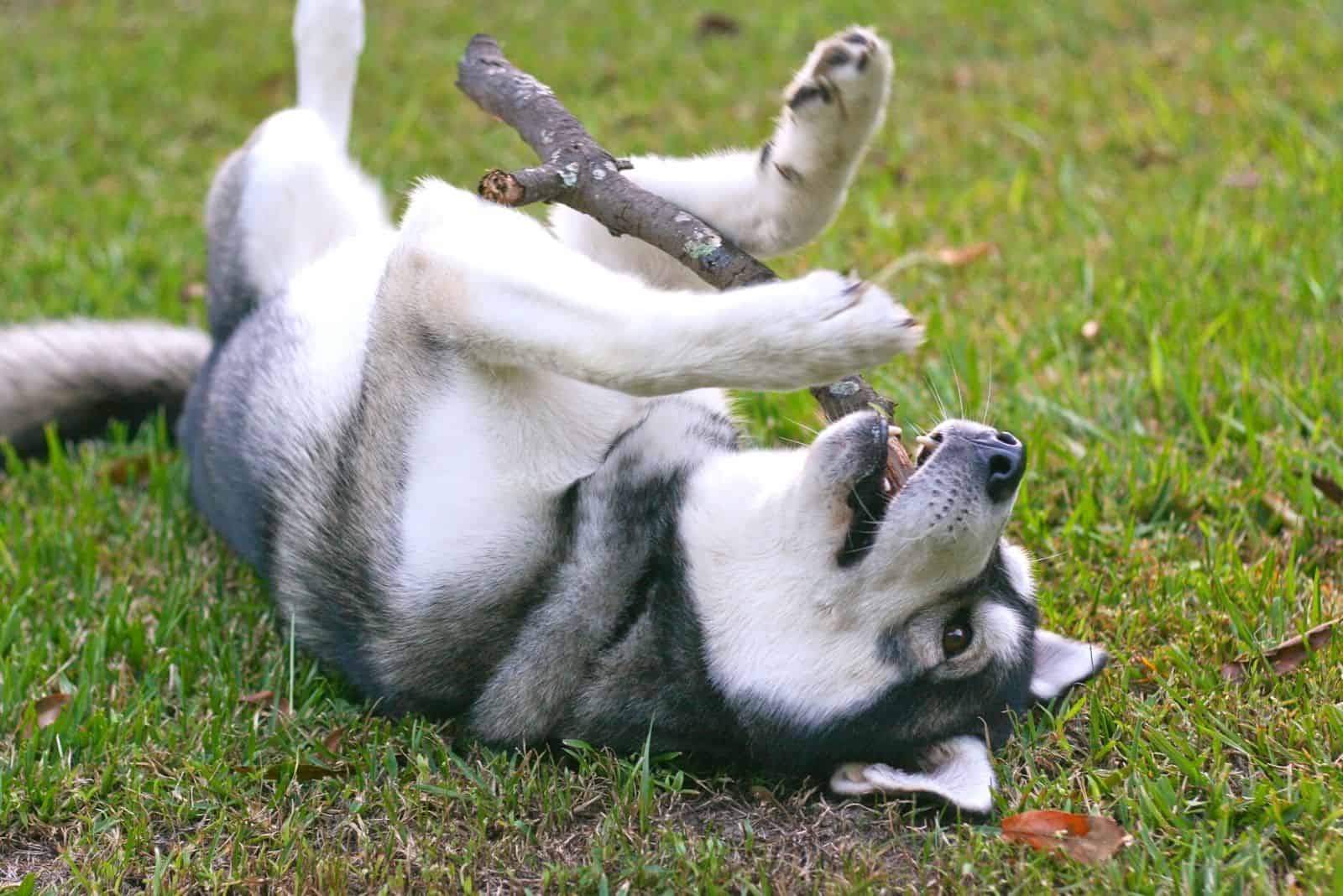
Don’t panic! The whole thing should be over by the time your Husky puppy is 7 or 8 months of age. Considering that Huskies have an average lifespan of 12–15 years, that only accounts for a small proportion of their lives.
Each dog is different, and some will have an easier time of it than others. But it’s never pleasant to see your best friend going through pain and discomfort.
By the time they reach 8 months, all of the discomforts of Husky teething should be behind you.
The best thing you can do during the process is to be there for them and give them all the love and care they need. Here are some helpful tips on how to ease those sore gums.
How To Help A teething Husky
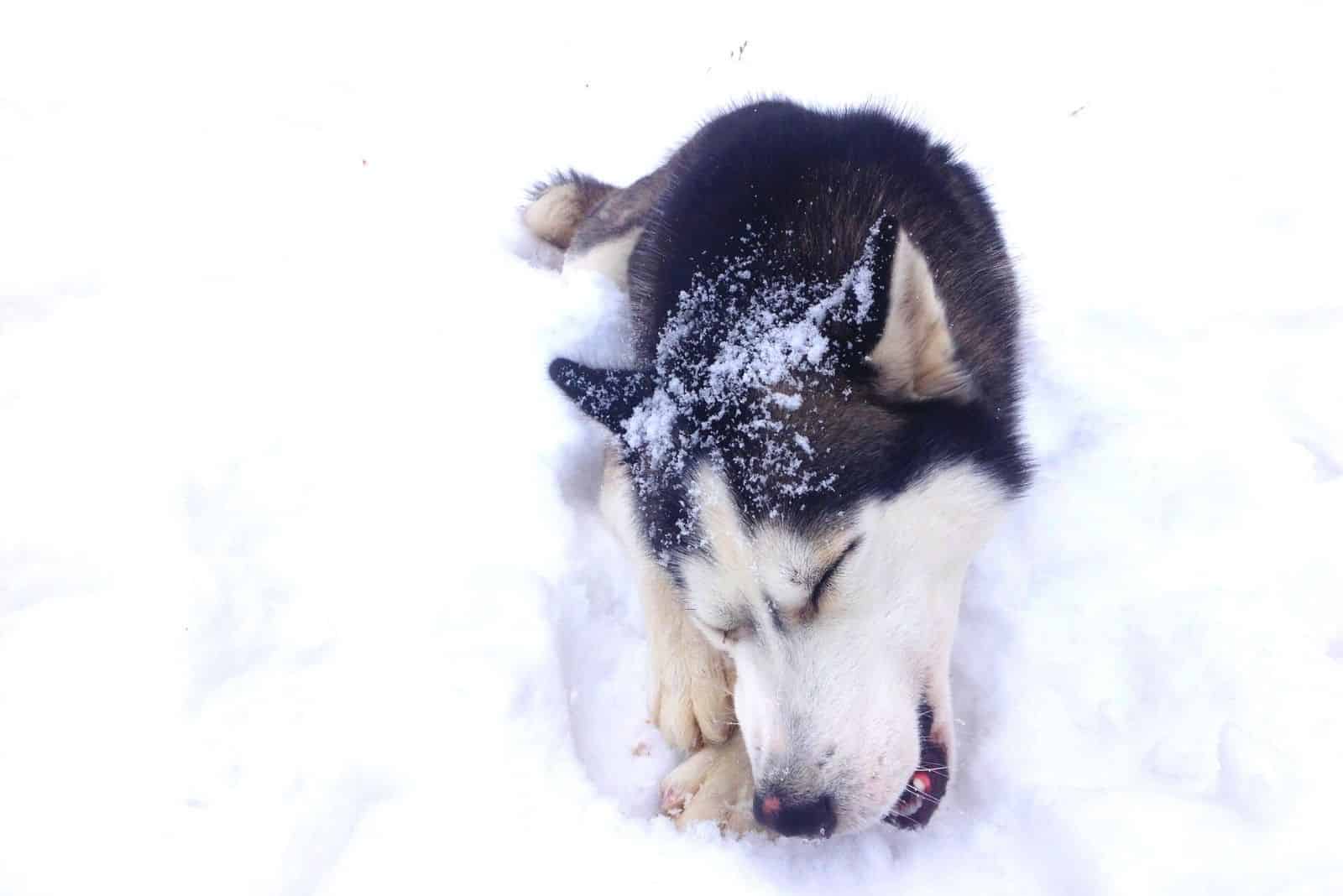
There are several ways to help your Siberian Husky pup through the teething process. It won’t solve every problem, but it will ease some of the pain and discomfort.
Try a combination of these to see which one works for you and your puppy:
• Ice cubes – this is a controversial suggestion as some experts believe that ice cubes are too hard and can crack a puppy’s teeth. A good compromise is to crush the ice first.
You can also make it more interesting by freezing stock, meat jelly, peanut butter*, banana (or other fruits), and even their favorite treat. This will cool their gums and taste good at the same time, giving them a welcome distraction from the discomfort.
• Playtime – mental and physical stimulation are essential to all dog breeds, especially those considered to be intelligent. Huskies are an intelligent breed and require exercise that challenges their mind as well as their body.
Establishing a routine playtime is a good way to improve your pup’s mental health and keep them fit and healthy.
This also contributes to the teething process as it ensures that they develop properly, as well as distracting them from any pain. Finally, it will help you to establish a firm bond with your pup.
Husky Teething Toys
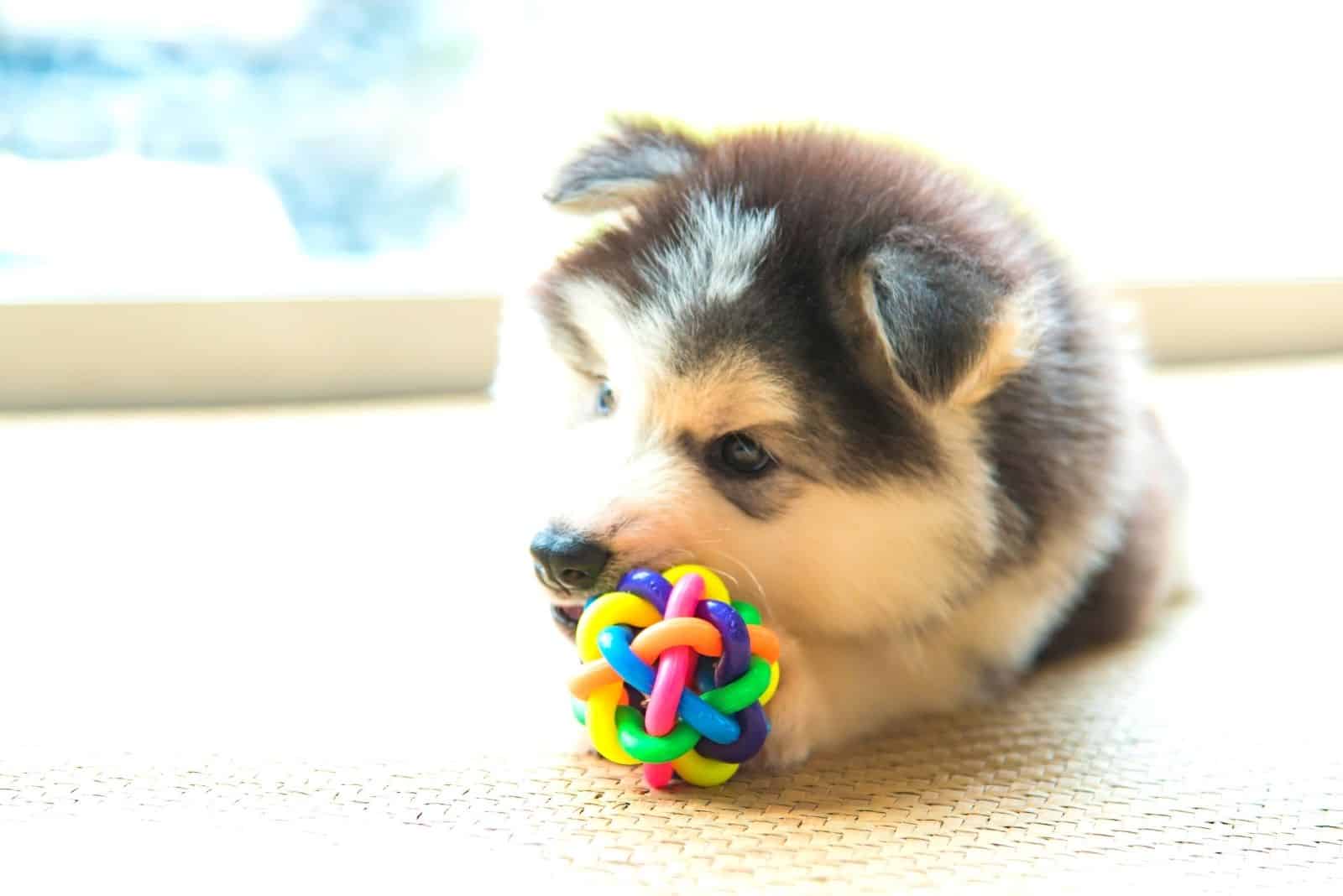
• Rope toys – a good choice for older pups, when the adult teeth are growing in. Be sure to choose a high-quality brand; otherwise, your Husky will rip it apart in no time! These are great for strengthening the teeth and jaws.
• Dog chews – again, you should select a trusted brand of chew toy, such as KONG. This can be filled with treats (perhaps frozen?) and will keep them occupied for a while, and they’ll get a reward that will help their sore gums at the end. Opinions are divided over rawhide, animal hooves, soup bones (knuckles, joints, etc.), antlers, and so on.
Most experts recommend that you avoid giving these to a teething puppy. Pieces of rawhide can break off and cause a choking hazard or intestinal blockage. You should also never give dogs cooked bones, as these can splinter, creating sharp points that can cause serious injury.
*When using peanut butter, you must take care to avoid any brand containing the artificial sweetener called xylitol. This is toxic to dogs, and even a small amount can be fatal.
Looking After Your Dog’s Teeth
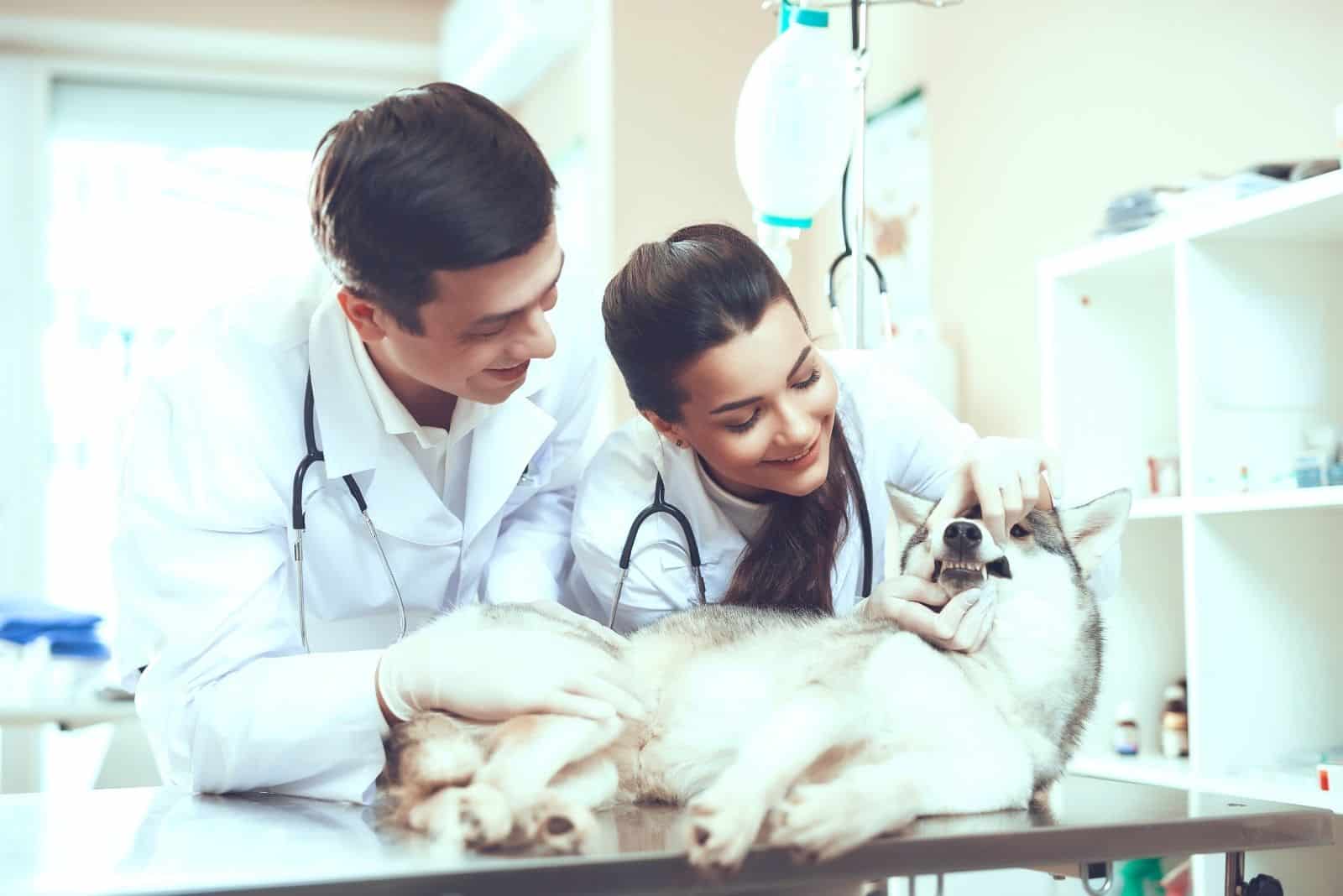
All dog owners should take responsibility for their furry friend’s teeth. Healthy teeth are essential to a dog’s overall well-being.
Tartar buildup isn’t just unsightly, but it can also lead to tooth decay and gum disease. If this wasn’t bad enough, infections from gum disease can be fatal to dogs if the bacteria makes its way into the bloodstream.
This can affect the heart, kidneys, and other vital organs and cause multiple organ failure.
So, you can see that investing in a good quality toothbrush and branded dog toothpaste makes sense! One important note: never use toothpaste designed for humans. Some of these have ingredients that are harmful to dogs, such as the artificial sweetener xylitol.
You should ideally start brushing your dog’s teeth when they are a puppy, around the time that their milk teeth grow.
This keeps their teeth clean and helps the pup get used to the process, as well as having their mouth handled, which is handy for vet visits when they are older.
How Often Should I Brush My Dog’s Teeth?
Ideally, every day! Some sources say twice a day, but that’s optional. The main aim is to reduce plaque and tartar buildup. If you really can’t manage daily brushing, then three days a week is a good compromise.
It may be a bit of a chore to start with, and your pooch might not feel like cooperating. Persevere if you can, though, and they’ll soon get used to it.
This is another bonus of starting when they are young, as, by the time they are fully grown, it will be second nature to them. In fact, they might even get to like it! If they don’t take to one brand or flavor of toothpaste, try another.
This is an important part of their grooming routine and should never be neglected. Another bonus for you is that your dog will have lovely fresh breath, which is great when they come to say hello and breathe directly in your face.
Husky Teething: A Summary
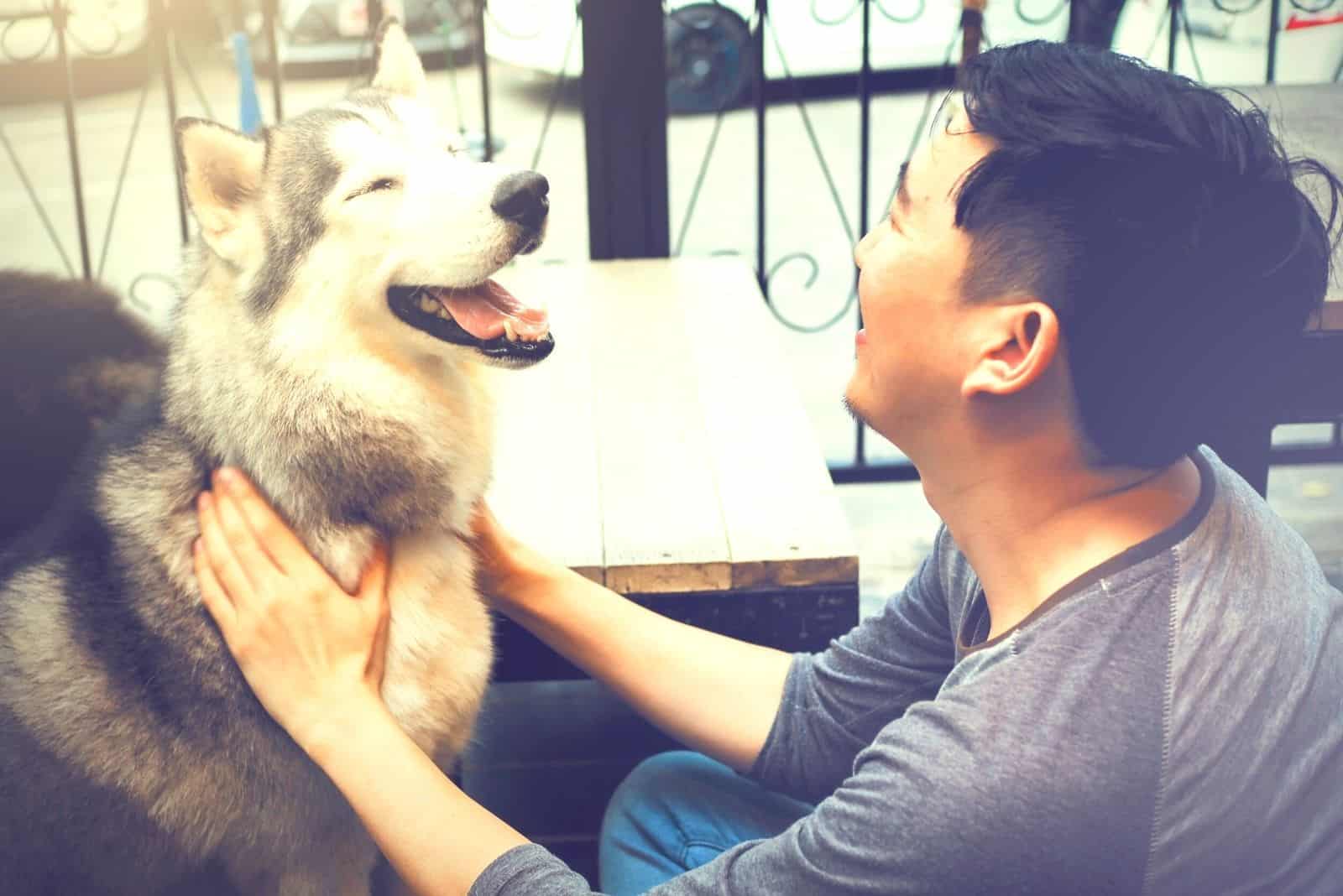
The Husky teething process isn’t something you can avoid. All pups will go through this stage – it’s just part of their natural development.
However, some breeders like to keep their pups a little longer, only allowing them to leave the kennels at around 12 to 16 weeks of age.
Although some people want to have that little ball of fluff when they’re really tiny (which is understandable because they’re just so cute!), you can avoid the first teething stage by getting your pup when they’re a bit older.
Their mother will possibly have spent some time teaching them about bite inhibition, and the breeder will probably have begun at least the first stages of deworming and vaccinations.
You might save yourself some stress this way, as they might have even grown some of their adult teeth.
Then again, many breeders are happy to let their pups go at 8 weeks old. They really shouldn’t be released anytime before this. By now, they should have all 28 of their baby teeth, so you won’t have that stage to contend with.
Before you get your pup, give some thought to how you will cope with the teething process. Research some safe dog chews, as inferior ones can be dangerous.
Look up some tips on what kind of things you can freeze to complement the suggestions we made earlier. Remember to crush the ice so that your pup doesn’t have to chew through solid ice cubes.
Invest in a KONG and similar good-quality dog chew toys.
Spend some time arranging a safe space for your pup where there are no hazards: they will literally chew anything.
You might set aside a place with a bed and an area to run and play, but are there any power cables trailing through?
Any plants, lamps, ornaments, wall sockets? None of these are safe from your puppy’s jaws!
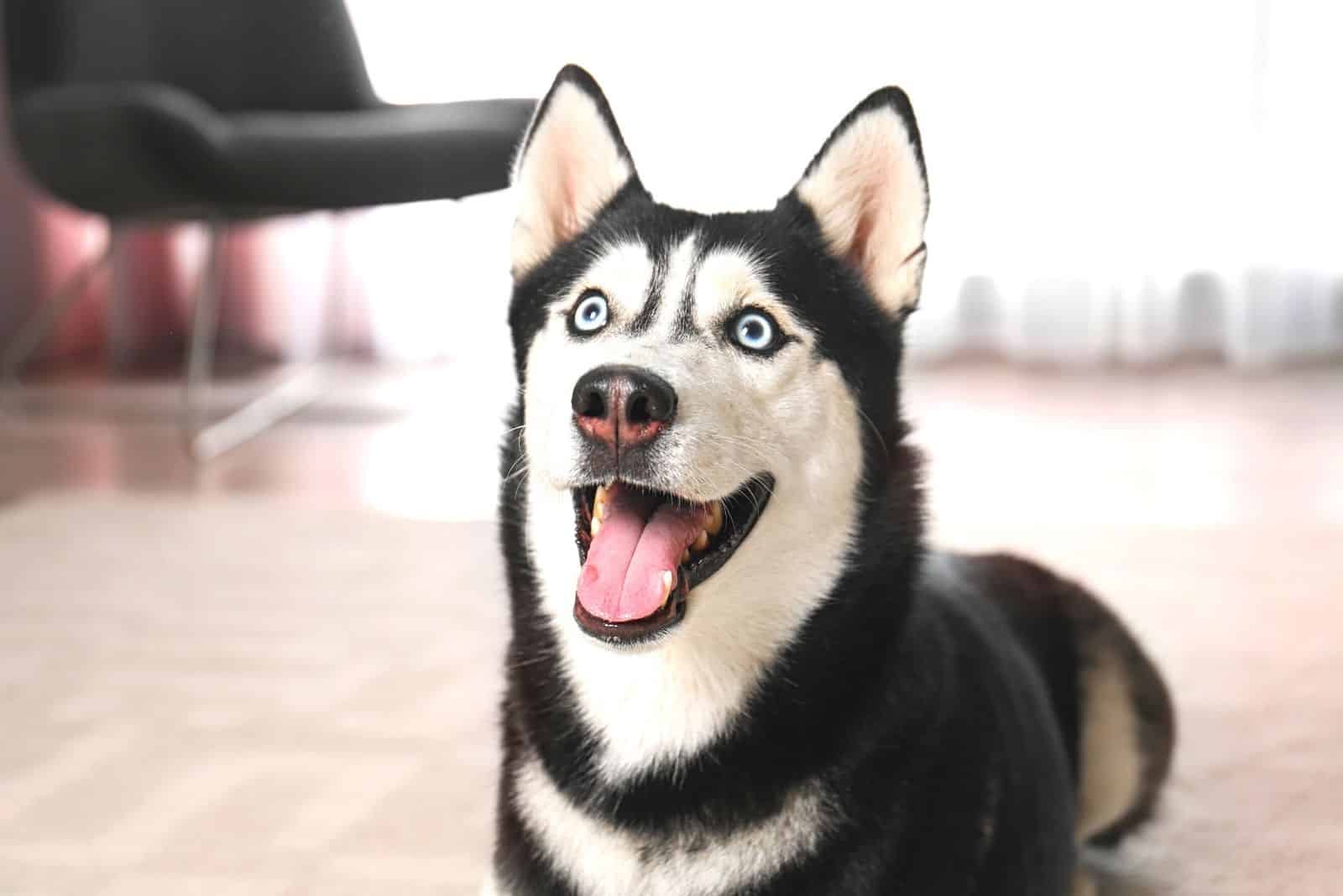
Always make sure they have something to chew on, and if you see them biting at something else, replace it with a suitable item.
Never be tempted to shout crossly, and by no means should you ever resort to smacking. This is counter-productive and can result in aggression at a later stage.
Positive reinforcement and reward-based training are the kindest and most effective ways of getting your dog to behave as you would like it to.
Once the ordeal is over, and their teeth have finally finished growing, then you need to make sure that biting hasn’t become a habit. This isn’t biting out of aggression, which is another matter entirely.
This is partly an extension of mouthing that pups do when playing. You’ll see older dogs doing this all the time, although there’s a subtle yet significant difference between this and actual biting.
Biting things just to chew them to pieces is done out of pure habit. And it needs to be stopped.
Your pup will associate biting with attention. What you need to do is to get them to realize that biting won’t benefit them at all.
Obedience classes are a good way to get your dog onside. You can use this as a way to encourage them into better habits.
When they realize that they will be rewarded for not chewing and biting, they’ll soon catch on. Your dog isn’t stupid!
Finally, you need to keep a close eye on them throughout this process. Some of the symptoms they display could be a sign of an unrelated health condition. If you have any concerns at all, then don’t delay in seeking help and advice.
Your pup might have a slight fever, as well as an upset tummy, while those pesky teeth are growing. These can lead to dehydration, which can be a serious problem for dogs, especially tiny puppies.
Never fear, though. The whole process should be finished by the time your Husky pup is seven months old, eight at the latest. Then you have many happy years of Husky joy to look forward to.
